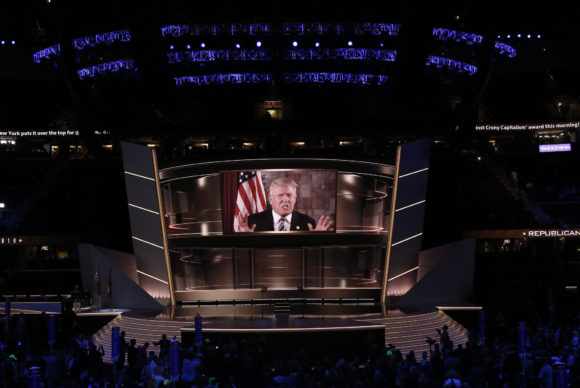One of the biggest surprises from the Republican convention so far has not taken place on its center stage. Yes, I’m talking about the party’s call in its 2016 platform to reinstate the Glass-Steagall law.
This is the statute that would require large U.S. institutions to break up — the cause that preoccupied Bernie Sanders’s presidential campaign and continues to animate the American left.
The Depression-era act, which forced financial institutions to divide into commercial and investment banking halves, was repealed under President Bill Clinton in 1999. It was a case of the law catching up with reality, after decades in which traditional banking, insurance and securities lines became blurred and the U.S. Federal Reserve granted so many waivers that the law existed mostly on paper.
Republicans usually celebrate the repeal of Glass-Steagall. So why have they purloined this liberal idea?
The about-face can’t be explained by the takeover of the party by Donald Trump, who until now hadn’t called for the law’s restoration. But it allows him to cast aspersions on Bill Clinton’s administration while helping him attract Sanders’s voters.
It also throws a harsh light on Hillary Clinton’s ties to Wall Street banks, which have contributed to her campaign and paid her huge fees for speeches. She believes that Glass-Steagall redux is irrelevant — though in a nod to Sanders, the Democratic platform endorses a modernized Glass-Steagall — and distracts from effective regulation of Wall Street (as I’ve written before).
Populist Prism
The GOP’s newfound love for Glass-Steagall is best understood not through Trumpism but through the populist prism of Main Street versus Wall Street and a starry-eyed fondness for smaller community

banks, which wouldn’t be affected by a Glass-Steagall comeback. The party is catering to its base in the rural South, Midwest and Mountain West, where antipathy toward big-city financiers has always run strong, and more so after the 2008 financial meltdown.
Trump’s running mate, Indiana Governor Mike Pence, is the perfect example of the anti-Wall Street mindset. As a Republican House member in 2008, he railed against bank and auto bailouts and voted against the $700 billion Troubled Asset Relief Program. His constituents cheered.
In place of the mega-banks, the party favors community banks, which the platform says are responsible for the majority of small-business loans. It also calls for dismantling the Dodd-Frank financial-reform law, which it blames for decimating community banks. “From 13,000 community banks in 1985, only 1,900 remain,” the platform document says, concluding that “The Dodd-Frank law, the Democrats’ legislative Godzilla, is crushing small and community banks.”
Small Banks
There are a couple problems with this. One, the U.S. has about 6,000 community banks, generally defined as those with up to $10 billion in assets.
Two, very small community banks are disappearing, but for reasons that have little to do with Dodd-Frank. There were 13,000 of them (with assets under $100 million) in the 1980s, but that number shrank to about 2,600 by 2010, even before the reform law was in force. (Now there are about 1,900 of them, which may be the source of the party’s calculation).
But there are still more than 4,000 larger community banks with assets above $100 million.
So if Dodd-Frank wasn’t the cause, what happened to the 7,000 community banks that have disappeared over the last few decades? Camden Fine, the head of the Independent Community Bankers of America, told me in an interview on Wednesday that most of the banks merged with others.
Mergers are how small banks become more efficient and improve margins, which have suffered because of the tiny spread between banks’ borrowing costs and the rates at which they can lend when interest rates are at rock bottom. Larger banks have been able to compensate for shrinking spreads by diversifying into other areas, including asset management and securities brokerage.
Fewer Start-Ups
But the main explanation for the community-bank shrinkage is that there have been far fewer small-bank start-ups, or what Fine calls “de novo activity.” One reason for this is that the Federal Deposit Insurance Corp., after the crisis and until recently, required new banks to submit to enhanced supervision for seven years, versus the traditional three years, after starting up. Entrepreneurs are reluctant to invest under those terms, and also because demand has been weak for community-bank services. But none of that has to do with Dodd-Frank, Fine told me, although regulatory burdens are a problem for small banks.
In any case, a 2015 Brookings Institution study says we shouldn’t worry that small banks are going away. They “are such a tiny part of the banking sector that their impact on the overall economy has been rather limited,” it concludes.
Republicans, then, would invite economic and financial chaos by using Glass-Steagall to break up big banks and repealing Dodd-Frank — all for political reasons.
This column does not necessarily reflect the opinion of the editorial board or Bloomberg LP and its owners.
Was this article valuable?
Here are more articles you may enjoy.



 How ‘Super Roofs’ Reward Insurers, Cat Bond Investors and Homeowners
How ‘Super Roofs’ Reward Insurers, Cat Bond Investors and Homeowners  Applied Systems, Comulate Spar Over Trade Secret Theft Allegations
Applied Systems, Comulate Spar Over Trade Secret Theft Allegations  Foundation Firmed: AM Best Switches View of US Homeowners Insurers to Stable
Foundation Firmed: AM Best Switches View of US Homeowners Insurers to Stable  Businessman, Former Federal Insurance Co. Attorney Hit With $50M Florida Verdict
Businessman, Former Federal Insurance Co. Attorney Hit With $50M Florida Verdict 

